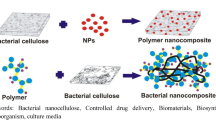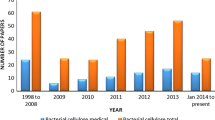Abstract
Bacterial cellulose (BC) is a pure form of cellulose and has some superior properties such as an ultrafine fiber network, high water-holding capacity and ease of fabrication into a desired shape. It has been widely studied for applications in tissue engineering, wound dressing, artificial skin and protein delivery. In the current study, BC matrices (12 mm diameter) were prepared and evaluated for in vitro release using famotidine and tizanidine as model drugs. The successful drug loading and uniform distribution into the matrices were confirmed through scanning electron microscopy and X-ray diffractrometry. Fourier transform infrared spectroscopy and thermogravimetric analysis revealed the chemical and thermal stability of the BC-drug composites, respectively. The percent drug loading of various matrices was in the range of 18.10–67.64%. Similarly, the friability test results were in the range of 0.69–0.83 and 0.14–0.89% for 20 and 40 mg/ml famotidine (low water soluble) loaded matrices, respectively, while no weight loss was observed in friability tests for formulations loaded with 6 mg/ml tizanidine (highly water soluble) because of the low dose and drug concentration. In vitro dissolution studies showed more than 80% drug release in the initial 15 min for all formulations, conforming to immediate release criteria. Comparison studies were carried out using famotidine and tizanidine commercial tablets. The results of current research work revealed that BC matrices have the potential for applications in single polymer-based oral drug delivery.







Similar content being viewed by others
References
Aamir MN, Ahmad M (2010) Production and stability evaluation of modified-release microparticles for the delivery of drug combinations. AAPS Pharm Sci Technol 11(1):351–355
Ahmad N, Amin MCIM, Mahali SM, Ismail I, Chuang VTG (2014) Biocompatible and mucoadhesive bacterial cellulose-g-poly (acrylic acid) hydrogels for oral protein delivery. Mol Pharm 11:4130–4142
Akers MJ (2002) Excipient–drug interactions in parenteral formulations. J Pharm Sci 91(11):2283–2300
Almeida IF, Pereira T, Silva NHCS, Gomes FP, Silvestre AJD, Freire CSR, Lobo JMS, Costa PC (2014) Bacterial cellulose membranes as drug delivery systems: an in vivo skin compatibility study. Eur J Pharm Biopharm 86(3):332–336
Alosmanov R, Wolski K, Zapotoczny S (2017) Grafting of thermosensitive poly(N-isopropylacrylamide) from wet bacterial cellulose sheets to improve its swelling-drying ability. Cellulose 24(1):285–293
Arima Y, Iwata H (2007) Effect of wettability and surface functional groups on protein adsorption and cell adhesion using well-defined mixed self-assembled monolayers. Biomaterials 28(20):3074–3082
Beneke CE, Viljoen AM, Hamman JH (2009) Polymeric plant-derived excipients in drug delivery. Molecules 14(7):2602–2620
Bielecki S, Krystynowicz A, Turkiewicz M, Kalinowska H (2005) Bacterial cellulose. Biopolymers Online. 5
Bodin A, Bharadwaj S, Wu S, Gatenholm P, Atala A, Zhang Y (2010) Tissue-engineered conduit using urine-derived stem cells seeded bacterial cellulose polymer in urinary reconstruction and diversion. Biomaterials 31(34):8889–8901
Cheng WT, Lin SY (2008) Famotidine polymorphic transformation in the grinding process significantly depends on environmental humidity or water content. Int J Pharm 357(1):164–168
Clasen C, Sultanova B, Wilhelms T, Heisig P, Kulicke WM (2006) Effects of different drying processes on the material properties of bacterial cellulose membranes. Macromol Symp 244(1):48–58
Crowley P, Martini LG (2001) Drug-excipient interactions. Pharm Technol 4:7–12
Crowley PJ, Martini LG (2010) Effects of excipients on the stability of medicinal products. Chim Oggi 28(5):VII–XIII
Czaja W, Krystynowicz A, Bielecki S, Brown RM (2006) Microbial cellulose—the natural power to heal wounds. Biomaterials 27(2):145–151
Eichhorn SJ, Dufresne A, Aranguren M, Marcovich NE, Capadona JR, Rowan SJ, Weder C, Thielemans W, Roman M, Renneckar S, Gindl W (2010) Current international research into cellulose nanofibres and nanocomposites. J Mater Sci 45(1):1–33
Esa F, Tasirin SM, Rahman NA (2014) Overview of bacterial cellulose production and application. Agric Agric Sci Procedia 2:113–119
Gayathry G, Gopalaswamy G (2014) Production and characterisation of microbial cellulosic fibre from Acetobacter xylinum. Indian J Fibre Text Res 39:93–96
Gupta RB, Kompella UB (2006) Nanoparticle for technology drug delivery. Taylor & Francis, New York
Gupta V, Ain S, Babita K, Ain Q, Dahiya J (2013) Solubility enhancement of the poorly water soluble antiulcer drug famotidine by inclusion complexation. IJPSN 6(1):1983–1989
Hu W, Chen S, Yang J, Li Z, Wang H (2014) Functionalized bacterial cellulose derivatives and nanocomposites. Carbohydr Polym 101:1043–1060
Huang C, Guo HJ, Xiong L, Wang B, Shi SL, Chen XF, Lin XQ, Wang C, Luo J, Chen XD (2016) Using wastewater after lipid fermentation as substrate for bacterial cellulose production by Gluconacetobacter xylinus. Carbohydr Polym 136:198–202
Jackson K, Young D, Pant S (2000) Drug–excipient interactions and their affect on absorption. Pharm Sci Technol Today 3(10):336–345
Jain CP, Naruka PS (2009) Formulation and evaluation of fast dissolving tablets of valsartan. Int J Pharm Pharm Sci 1(1):219–226
Ju ZY, Howard LR (2003) Effects of solvent and temperature on pressurized liquid extraction of anthocyanins and total phenolics from dried red grape skin. J Agric Food Chem 51(18):5207–5213
Khan T, Hyun SH, Park JK (2007) Production of glucuronan oligosaccharides using the waste of beer fermentation broth as a basal medium. Enzyme Microb Technol 42(1):89–92
Khattak WA, Khan T, Ul-Islam M, Ullah MW, Khan S, Wahid F, Park JK (2015a) Production, characterization and biological features of bacterial cellulose from scum obtained during preparation of sugarcane jaggery (gur). J Food Sci Technol 52(12):8343–8349
Khattak WA, Khan T, Ul-Islam M, Wahid F, Park JK (2015b) Production, characterization and physico-mechanical properties of bacterial cellulose from industrial wastes. J Polym Environ 23(1):45–53
Lin SP, Calvar IL, Catchmark JM, Liu JR, Demirci A, Cheng KC (2013) Biosynthesis, production and applications of bacterial cellulose. Cellulose 20(5):2191–2219
Lindner GR, Dalmolin LF, Khalil NM, Mainardes RM (2015) Influence of the formulation parameters on the particle size and encapsulation efficiency of resveratrol in PLA and PLA-PEG blend nanoparticles: a factorial design. J Nanosci Nanotechnol 15(12):10173–10182
Malak NSA (2012) Formulation of coated polymer reinforced gellan gum beads of tizanidine hydrocholride using fractional factorial design. Int J Pharm Pharm Sci 4(5):369–379
Mohite MT, Shet S, Shaikh S, Aaidya V, Karodi R (2010) Analytical method development for famotidine USP in bulk and single component formulations. Int J Res Ayurveda Pharm 1(2):475–479
Olyveira GM, Costa LMM, Basmaji P (2013) Physically modified bacterial cellulose as alternative routes for transdermal drug delivery. J Biomat Tissue Eng 3(2):227–232
Narang AS, Desai D, Badawy S (2012) Impact of excipient interaction on solid dosage form stability. Pharm Res 29(10):2660–2683
O’reilly SE, Strawn DG, Sparks DL (2001) Residence time effects on arsenate adsorption/desorption mechanisms on goethite. Soil Sci Soc Am J 65(1):67–77
Oshima T, Taguchi S, Ohe K, Baba Y (2011) Phosphorylated bacterial cellulose for adsorption of proteins. Carbohydr Polym 83(2):953–958
Park JK, Khan T, Jung JY (2009) Bacterial cellulose. In: Phillips GO, Williams PA (eds) Handbook of hydrocolloids. Woodhead Publishing Ltd., Abington, pp 724–739
Patel P, Ahir K, Patel V, Manani L, Patel C (2015) Drug-Excipient compatibility studies: First step for dosage form development. Pharm Innov J 4(5):14–20
Pavaloiu RD, Stoica-Guzun A, Stroescu M, Dobre T (2014) Use of bacterial cellulose as reinforcement agent and as coating agent in drug release applications. Rev Chim 65(7):852–855
Rouabhia M, Asselin J, Tazi N, Messaddeq Y, Levinson D, Zhang Z (2014) Production of biocompatible and antimicrobial bacterial cellulose polymers functionalized by RGDC grafting groups and gentamicin. ACS Appl Mater Interfaces 6(3):1439–1446
Ruths M, Yoshizawa H, Fetters LJ, Israelachvili JN (1996) Depletion attraction versus steric repulsion in a system of weakly adsorbing polymer effects of concentration and adsorption conditions. Macromolecules 29(22):7193–7203
Sagdinc S, Bayarı S (2005) Experimental and theoretical infrared spectra of famotidine and its interaction with ofloxacin. J Mol Struct 744:369–376
Serafica G, Mormino R, Oster GA, Lentz KE, Koehler KP (2010) Microbial cellulose wound dressing for treating chronic wounds. US patent US 7704523:B2
Shaikh H, Memon N, Khan H, Bhanger MI, Nizamani SM (2012) Preparation and characterization of molecularly imprinted polymer for di (2-ethylhexyl) phthalate: application to sample clean-up prior to gas chromatographic determination. J Chromatogr A 1247:125–133
Shezad O, Khan S, Khan T, Park JK (2009) Production of bacterial cellulose in static conditions by a simple fed-batch cultivation strategy. Korean J Chem Eng 26(6):1689–1692
Singh J, Bajpai M (2011) Effect of superdisintegrants in the formulation of taste-masked orodispersible tablets of Tizanidine HCl. J Pharm Res 4(7):2175–2178
Sultana B, Anwar F, Ashraf M (2009) Effect of extraction solvent/technique on the antioxidant activity of selected medicinal plant extracts. Molecules 14(6):2167–2180
Tripathi R, Mishra B (2012) Development and evaluation of sodium alginate polyacrylamide graft–co-polymer-based stomach targeted hydrogels of famotidine. AAPS Pharm Sci Technol 13(4):1091–1102
Tsouko E, Kourmentza C, Ladakis D, Kopsahelis N, Mandala I, Papanikolaou S, Paloukis F, Alves V, Koutinas A (2015) Bacterial cellulose production from industrial waste and by-product streams. Int J Mol Sci 16(7):14832–14849
Ul-Islam M, Khan T, Park JK (2012a) Nanoreinforced bacterial cellulose montmorillonite composites for biomedical applications. Carbohydr Polym 89(4):1189–1197
Ul-Islam M, Khan T, Park JK (2012b) Water holding and release properties of bacterial cellulose obtained by in situ and ex situ modification. Carbohydr Polym 88(2):596–603
Ul-Islam M, Ha JH, Khan T, Park JK (2013) Effects of glucuronic acid oligomers on the production, structure and properties of bacterial cellulose. Carbohydr Polym 92(1):360–366
Ullah H, Santos HA, Khan T (2016a) Applications of bacterial cellulose in food, cosmetics and drug delivery. Cellulose 23(4):2291–2314
Ullah H, Wahid F, Santos HA, Khan T (2016b) Advances in biomedical and pharmaceutical applications of functional bacterial cellulose-based nanocomposites. Carbohydr Polym 150:330–352
Ullah H, Badshah M, Mäkilä E, Salonen J, Shahbazi MA, Santos HA, Khan T (2017) Fabrication, characterization and evaluation of bacterial cellulose-based capsule shells for oral drug delivery. Cellulose 24(3):1445–1454
Viridén A, Wittgren B, Larsson A (2011) The consequence of the chemical composition of HPMC in matrix tablets on the release behaviour of model drug substances having different solubility. Eur J Pharm Biopharm 77(1):99–110
Wan YZ, Hong L, Jia SR, Huang Y, Zhu Y, Wang YL, Jiang HJ (2006) Synthesis and characterization of hydroxyapatite–bacterial cellulose nanocomposites. Compos Sci Technol 66(11):1825–1832
Wening K, Laukamp EJ, Thommes M, Breitkreutz J (2012) Individual oral therapy with immediate release and effervescent formulations delivered by the solid dosage pen. J Pers Med 2(4):217–231
Williams DBG, Lawton M (2010) Drying of organic solvents: quantitative evaluation of the efficiency of several desiccants. J Org Chem 75(24):8351–8354
Author information
Authors and Affiliations
Corresponding author
Rights and permissions
About this article
Cite this article
Badshah, M., Ullah, H., Khan, S.A. et al. Preparation, characterization and in-vitro evaluation of bacterial cellulose matrices for oral drug delivery. Cellulose 24, 5041–5052 (2017). https://doi.org/10.1007/s10570-017-1474-8
Received:
Accepted:
Published:
Issue Date:
DOI: https://doi.org/10.1007/s10570-017-1474-8




